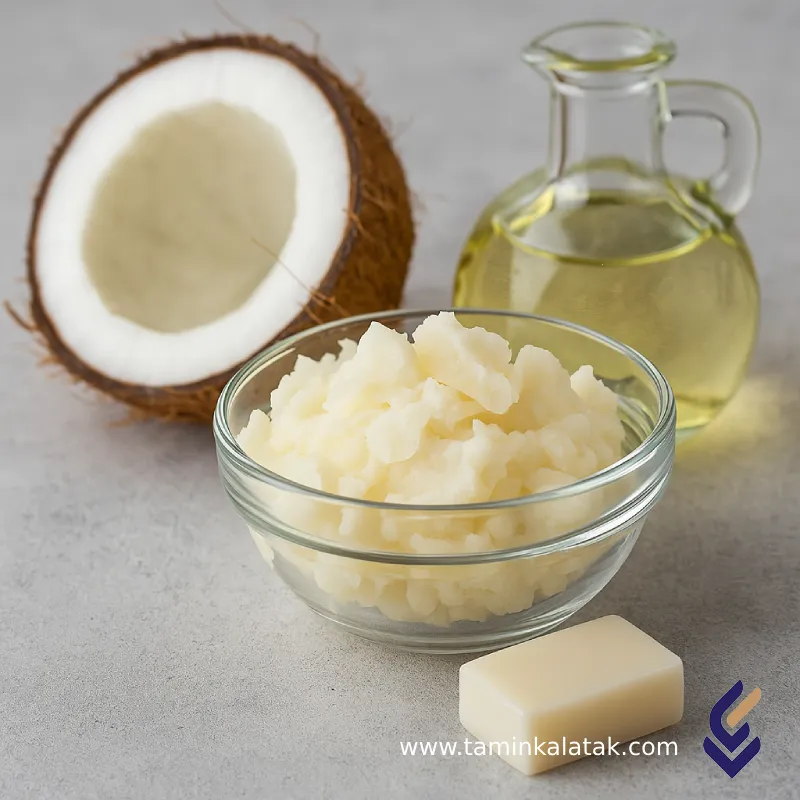Coconut fatty acid
Coconut Fatty Acid is a natural mixture of saturated fatty acids with short to medium carbon chains, obtained through the hydrolysis or saponification of coconut oil. Due to its unique molecular structure, it has wide applications across various industries, particularly in cosmetics, personal care, and detergents. Over 90% of its composition consists of saturated fatty acids, with the main components being:
-
Lauric acid (C12:0): ~45–52%
-
Myristic acid (C14:0): ~16–21%
-
Capric acid (C10:0): ~4–8%
-
Caprylic acid (C8:0): ~5–10%
Minor amounts of Palmitic acid (C16:0) and Stearic acid (C18:0) are also present.
Chemical Structure of Coconut Fatty Acid
The structure of coconut fatty acids consists of saturated alkyl chains (C8–C18) with a carboxyl group (-COOH) at the end of each chain. This structure provides the following properties:
-
Short to medium carbon chains (C8–C14)
-
High saturation: strong resistance to oxidation
-
High reactivity: suitable for producing soaps, esters, and amides
Properties of Coconut Fatty Acid
Physical state: Solid or semi-solid at room temperature
Odor: Mild, natural coconut scent
Iodine value: Low (indicating high saturation)
High surface activity:
-
Capable of reducing surface tension, making it ideal for surfactant production
-
Plays a crucial role in emulsification in cosmetic, detergent, and pharmaceutical products
Thermal and chemical stability:
-
More resistant to oxidation compared to oils containing unsaturated fatty acids
-
Stable under moderate heat and alkaline conditions
High biodegradability:
-
Eco-friendly and biodegradable composition
-
Excellent for sustainable product formulations
Plant-based and renewable origin:
-
Derived from natural, renewable coconut oil sources
High skin compatibility:
-
Non-toxic and gentle on skin, suitable for personal care formulations
-
Antibacterial properties, especially due to Lauric acid
Applications of Coconut Fatty Acid
Detergent and Hygiene Industries
-
Production of plant-based, transparent, and handmade soaps
-
Used in shampoos, conditioners, body washes, and shower gels
-
Raw material for foam boosters and mild surfactants such as Cocamide DEA/MEA
Cosmetic Industry
-
Used in moisturizing creams, lotions, lip balms, and hair oils
-
Ideal for formulations targeting dry and sensitive skin
Food Industry
-
Source of MCTs (Medium Chain Triglycerides) in therapeutic diets
-
Used as an anti-foaming agent or emulsifier in food processing
Industrial and Chemical Applications
-
Production of amides, esters, surfactants, and resins
-
Additive in plastics, coatings, lubricants, and adhesives
-
Bio-based feedstock for biodiesel, epoxides, and bio-lubricants
Advantages of Coconut Fatty Acid
-
Natural and renewable plant-based source
-
Biodegradable and environmentally friendly
-
High foaming capability in soap formulations
-
Excellent thermal and light stability
-
Skin-friendly, non-irritating even for sensitive skin
-
Suitable for MCT oil production in ketogenic and therapeutic diets
Disadvantages of Coconut Fatty Acid
-
Higher cost compared to animal- or petroleum-based fatty acids
-
Potential for mild allergic reactions in individuals with extremely sensitive skin
-
In dietary use, high saturated fat content requires moderate consumption
-
Solidifies at low temperatures, which may affect product appearance
Price of Coconut Fatty Acid
Due to its broad range of applications, coconut fatty acid is one of the most widely used plant-based fatty acids in various industries. Its price fluctuates depending on factors such as purity level, country of origin, coconut oil market volatility, shipping and import costs, and exchange rate variations.
In the Iranian market, it is commonly supplied in barrels or bulk containers by various suppliers. Industrial buyers are advised to review technical specifications—including Lauric acid content, iodine index, and melting point—before purchasing. For optimal quality and pricing, it is essential to evaluate the supplier source, product analysis, and transportation conditions.
Safety and Storage of Coconut Fatty Acid
| Category | Details and Recommendations |
|---|---|
| Hazard Classification | Generally non-hazardous under GHS for cosmetic and industrial grades |
| Skin Contact | Concentrated or unrefined forms may cause dryness or mild irritation — gloves recommended |
| Eye Contact | Direct exposure may cause stinging or redness — rinse immediately with plenty of water |
| Inhalation of Vapors/Particles | Not hazardous, but ensure adequate ventilation during melting or heating |
| Accidental Ingestion | Industrial grades are not for ingestion; food-grade is safe within regulated limits |
Applications
| Applications | , , , , |
|---|
Coconut fatty acid
| Products | Chemical formula | CAS number | Solubility in water | Melting point | Density (at 20°C) | Physical appearance | Vapor pressure | Grade |
|---|---|---|---|---|---|---|---|---|
| Fatty acids, C8–C18 and C18‑unsaturated (mixed coconut fatty acids) | Mixed – includes C₈H₁₆O₂, C₁₀H₂₀O₂, C₁₂H₂₄O₂, C₁₄H₂₈O₂ and other saturated/unsaturated acids | 61788‑47‑4 | Approximately 0.113 g/L at 20 °C; almost insoluble | About 20–28 °C (average about 24–28 °C) | Approximately 0.84–0.86 g/cm³ (Acme-Hardesty); 0.92 g/cm³ (PubChem – coconut oil) | Clear to translucent, white or light yellow oily liquid, semi-solid at lower temperatures | < 1 mmHg (≈<133 Pa) at about 131 °C | Industrial grade; cosmetic/food grade available with additional purification |







